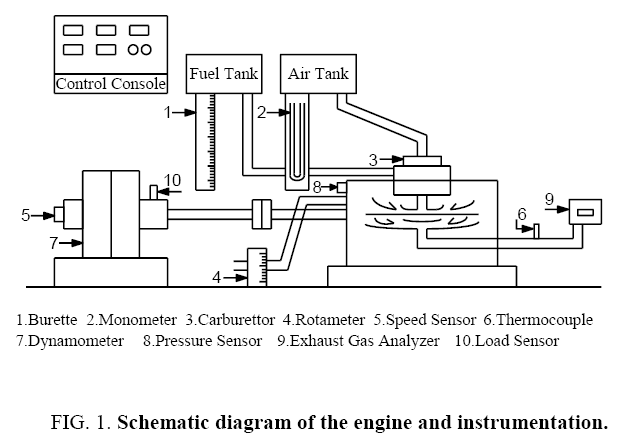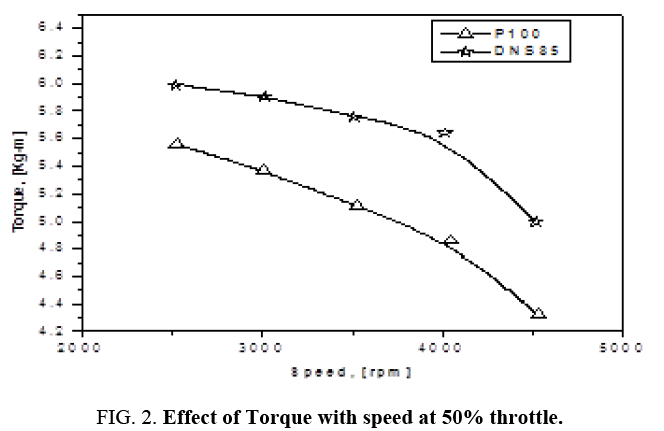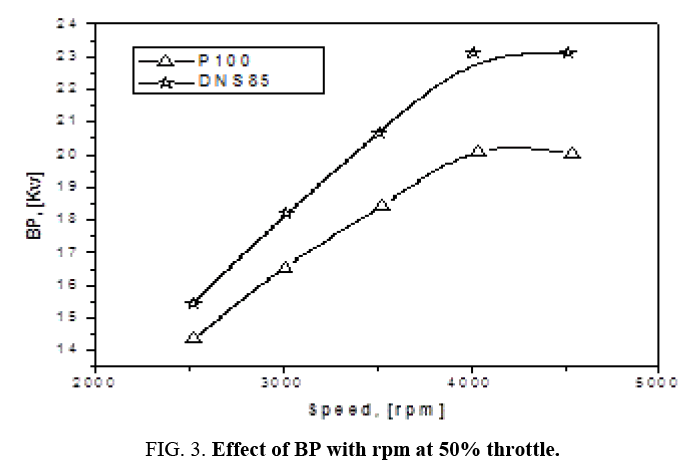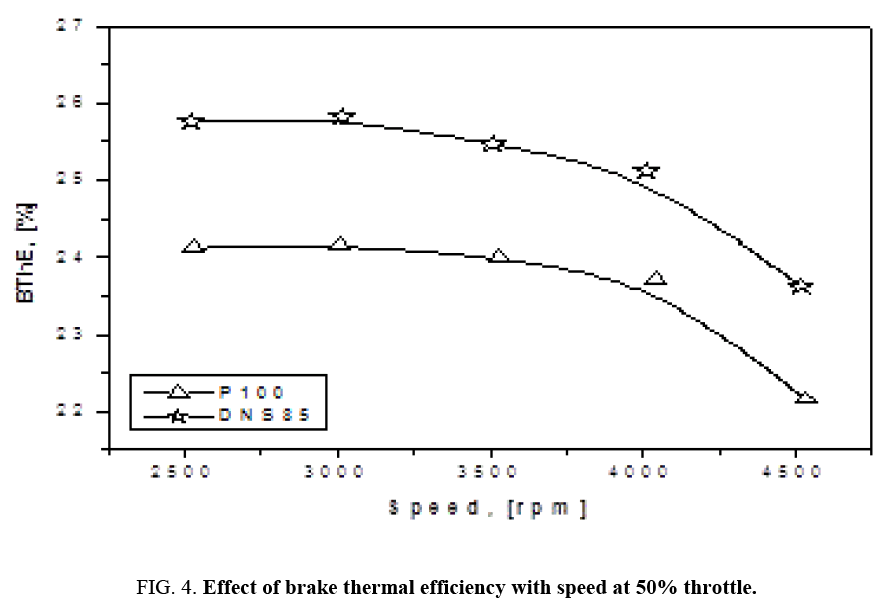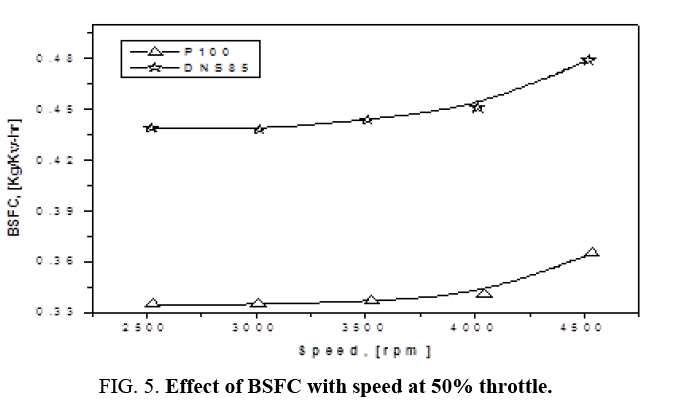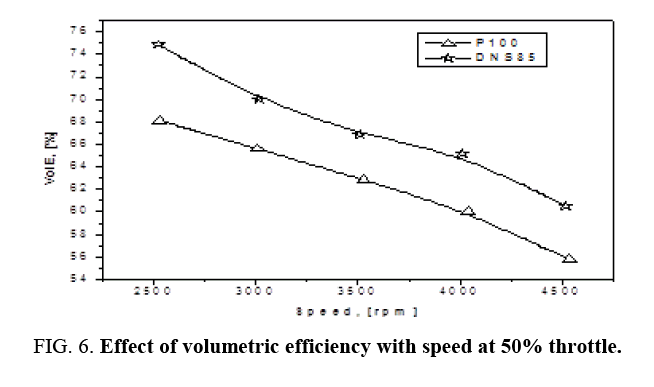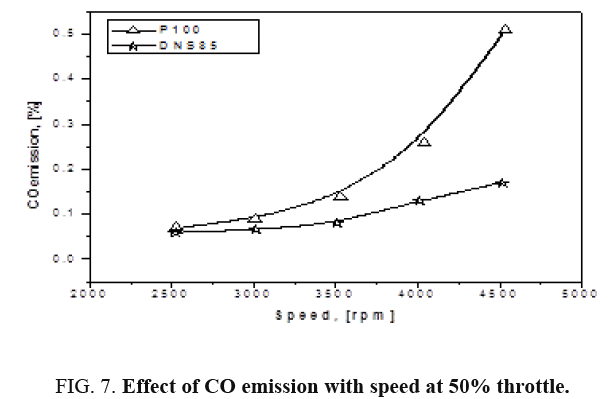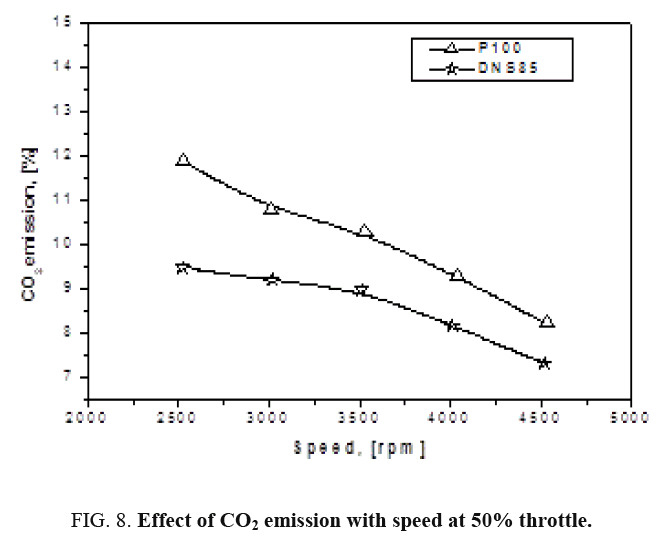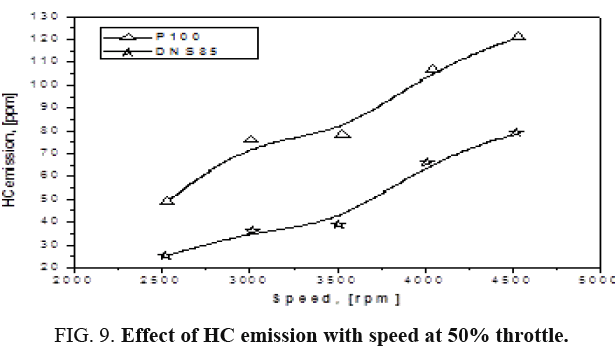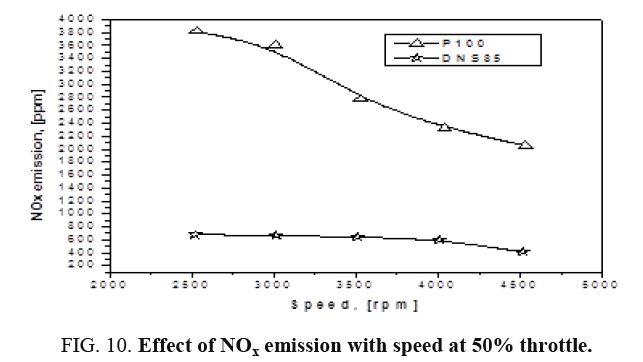Original Article
, Volume: 15( 4)Influence of Ethanol-Water Blends in Spark Ignition Engine Performance and Emissions Operated with Gasoline
- *Correspondence:
- Balaji Dhanapal, Department of Mechanical Engineering, Hindustan University, Chennai, Tamil Nadu, India, Tel: 0431-2660108; E-mail: balsnaga2002@yahoo.com
Received: July 21, 2017; Accepted: August 03, 2017; Published: August 11, 2017
Citation: Balaji D, Balu R, Jenoris M. Influence of Ethanol-Water Blends in Spark Ignition Engine Performance and Emissions Operated with Gasoline. Int J Chem Sci. 2017;15(4):179
Abstract
The objective of this study is to investigate the effect of using DNS85 (ethanol 79.3%+water 5.7%+gasoline 15%) as fuel in a four cylinder four strokes SI engine. In the process of investigation, the performance tests were conducted on the engine to analyze volumetric efficiency, brake thermal efficiency, brake power, engine torque and brake specific fuel consumption. Exhaust emissions were also investigated for carbon monoxide (CO), hydrocarbons (HC), oxides of nitrogen (NOx) and carbon dioxide (CO2). Experiments are conducted at 50% throttle opening position at different engine speeds ranging between 2500 rpm to 4500 rpm. The results of the experiments revealed that, blending the unleaded gasoline with denatured spirit increases the brake thermal efficiency, volumetric efficiency, brake power, engine torque and brake specific fuel consumption. The CO, HC, NOx and CO2 emissions in the exhaust decrease. The DNS85 as fuel produced the encouraging results in engine performance and reduced exhaust emissions for all the tested speeds and measured performance parameters.
Keywords
Denatured spirit (DNS); Ethanol; Alternative fuel; Emissions; P100 (Gasoline); DNS85
Introduction
As the world leads to the civilization and advancement in day to day life the need for newer things keep on popping up as the resources tend to deplete at a faster rate. Automobile industry is not being an exception; the world uses gasoline fuels to such an extent that today the whole world is searching for newer renewable and non-polluting automotive fuels. Apart from problem of fast vanishing reserves and irreplaceable nature of petroleum fuels, another important aspect of their use is the extent and nature of environmental pollution caused by their combustion in vehicular engines. Petroleum fueled vehicles discharge significant amount of pollutants like CO, HC, NOx, CO2, soot and particulates. Several fuel additives are identified; these can be added to gasoline in order to improve the octane rating and performance of the fuel in SI engines. Among many additives oxygenates have shown the promising results in the SI engines. Among oxygenates ethanol, methanol, tertiary butyl alcohol and methyl tertiary butyl ether are a few important additives under consideration. Ethanol seems to be one of the promising alternative fuel for SI engines owing to the fact that, it has high octane rating, leaner flammability limit, higher flame speed, high latent heat of vaporization and renewable in nature. Kameoka et al. [1] studied the effect of alcohol fuels on fuel-line materials and reported the corrosion of fuel system components. Latey et al. [2] conducted experiments using methanol 5% and maximum 20% ethanol in a single cylinder SI engine and reported the improved engine performance and lower emission characteristics. Yuksel and Yuksel [3] and Song et al. [4] used 60% ethanol-40% gasoline blend on a four-cylinder SI engine and concluded that, the torque output and consumptions of engine increased slightly, CO and HC emissions decreased dramatically and CO2 emissions were increased. Bayraktar [5] carried out the experiments with blends in lower proportions of 1.5, 3, 4.5, 6, 7.5, 9, 10.5 and 12 volumes % ethanol and reported that 7.5% ethanol was the most suitable for engine performance and CO emission point of view. Oldberding et al. [6] carried out dynamometer testing of an ethanol water fueled transit van and concluded important factors; mainly the advantage of replacing the conventional ignition system by a catalytically assisted ignition system, decreased NOx formation, reduced CO emissions, slight decrease in CO2 emissions and increase in the thermal efficiency. Yücesu et al. [7] conducted experiments on a single cylinder variable compression ratio SI engine to study the performance and exhaust emissions using ethanol-gasoline blends. The fuel blends used were E0, E10, E20, E40 and E60. The experiments were conducted at six compression ratios from 8:1 to 13:1 for each blend. It was found in this experiment that; there was an increase in the torque at higher compression ratios. The fuels containing high ratios of ethanol namely E40 and E60 had important effect on the reduction of emissions. The considerable decrease was obtained with HC as compared to CO. Jia et al. [8] studied the effect of E10 on a four-stroke motor cycle engine and reported reduction in CO, HC, acetaldehyde and ethylene. Maheshwari et al. [9] studied a few projects sponsored by Ministry of Petroleum and Natural Gas India. The focus of the study was to use 10% ethanol in gasoline and examine the start ability, drivability and mass emission for regulated pollutants without modifying any of the existing components of the engines of the test vehicles. The results show that the addition of 5% to 10% ethanol to gasoline increases the octane number by 1.3 to 3.4 units. Hence the addition of benzene and MTBE in refineries can replace with ethanol. In start ability tests on two wheelers and four wheelers the operations were satisfactory. In mass emission studies two wheelers show slight increase in HC emissions with 5% to 10% addition of ethanol, but in case of two wheelers fitted with catalytic converters both HC and CO were reduced. In case of four wheelers reduction of both HC and CO was noticed with marginal increase in NOx. Al-Hasan [10] conducted experiments on a four stroke four cylindered SI engine. The fuels used to investigate the performance of the engine were the gasoline-ethanol-blends in different proportions. The variable engine speed was between 1000 rpm and 4000 rpm. The experiments were conducted at three fourth throttle opening position. The range of ethanol percentage added to the gasoline is from 5% to the maximum of 30%. In his findings, it was mentioned that the performance of the engine improves with gasoline ethanol blends. Caviz et al. [11] reported that the 10% ethanol blend gave promising results while studying the coefficient of variation in indicated mean effective pressure, CO and HC emissions in the study of cyclic variability of engine. Maji et al. [12] carried out the experiments to evaluate the engine performance and exhaust emissions of CO and HC with ethanol-gasoline blends in a single cylinder four stroke SI engine. The changing parameters considered in this experiment were engine speed, compression ratio, air fuel ratio, ignition timing and intake air temperature. In these experiments fuel blends E85 and E15 were used. The findings of this work were the maximum power with ethanol blends was achieved near stoichiometric ratio and HC emissions reduced with E85. Intake air heating did not improve the performance of the engine and retarding the ignition time showed the improved performance of the engine with E85. Jeuland et al. [13] concentrated their studies to minimize the greenhouse gas (CO2) emission in dedicated engine experiment and reported reduction of CO2 up to 20% with increased engine efficiency.
Experimental Apparatus and Procedure
Engine and equipment
Experimental set up consists of a four strokes, four cylinder carburetor SI engine coupled with an eddy current dynamometer. The specifications of engine, dynamometer and exhaust gas analyzer are given in Tables 1, 2 and 3 respectively. Figure 1 shows a schematic diagram of the engine and instrumentation. Engine can be loaded by dynamometer through a potentiometer provided on the panel. The dynamometer load was measured by a load cell. The dynamic combustion pressure in the combustion chamber was sensed by a water cooled piezo sensor. Fuel flow was sensed by measuring hydrostatic head in the metering pipe by D.P. transmitter. The air flow was sensed by the orifice at the inlet of the air box. The differential pressure across the orifice was sensed by D.P. transmitter and differential pressure is also readable on the manometer. The exhaust gases under consideration were measured by MRU Delta 1600 S.
| Make | Premier(FIAT) |
|---|---|
| BHP | 39 BHP at 5000 rpm |
| Bore | 68.00 mm |
| Stroke | 75.00 mm |
| Cubic capacity | 1.089 litres |
| Compression ratio | 7.8:1 |
| Engine cooling | Water cooled |
Table 1: Test engine specifications.
| Dynamometer | Type: Eddy current. Model: E-50 |
|---|---|
| Cylinder pressure measurement | By piezo sensor |
| Crank position measurement | By rotary encoder |
| Analysis | Through computer software |
| Interfacing | ADC/DAC Card |
| Power consumption | 4 kW max |
| Overall dimension (mm) | 3800 × 2500 × 1500 |
Table 2: Specifications of dynamometer.
| Make | MRU delta 1600S |
|---|---|
| Storage temperature | -20°C to 50°C |
| Measured gases | |
| HC-Hydrocarbons as n-Hexane | |
| CO-Carbon monoxide | |
| CO2-Carbon dioxide (Optional) | |
| O2-Oxygen (Optionalthrough electrochemical sensor) | |
| NO-Nitric oxide (Optional through electrochemical sensor) | |
Table 3: Specification of exhaust gas analyzer.
Fuels
Commercially available unleaded gasoline is the base fuel. The denatured spirit (ethanol-93.3% v/v+water-6.7% v/v) of O.P (over proof) 63.7 is used in preparing the blend. The unleaded gasoline is blended with DNS to prepare DNS85 (ethanol 79.3%+water 5.7%+gasoline 15%).
Experimental procedure
The tests were performed at 2500 rpm, 3000 rpm, 3500 rpm, 4000 rpm and 4500 rpm, at 50% throttle position maintained throughout the experimentation. At lower speeds the sensors could not respond and log the data properly, hence such lower speed tests were not carried out. Being open loop engine test set up; it was not possible to exactly maintain the mentioned speeds at all the experiments and the variation of ± 2% speed was unavoidable. Each reading was taken at MBT position. While conducting experiments with each blend the necessary retarding of ignition timing was considered keeping in view the higher flame speed of DNS/ethanol. The test fuels used were gasoline and DNS85. The experiments were conducted at five different speeds between the mentioned range in the steps of 500 rpm increment for both the fuels. In order to compensate the leaning effect of DNS the necessary changes to the engine fuel supply system and the ignition systems were made. Before taking any reading with a particular fuel engine is made to run for at least ten minutes to attain the steady state condition. The required speed is obtained through the dynamometer load arrangement. Between switch over to a new fuel between the experiments, the previous fuel is completely burned in the engine and then the new fuel under consideration was filled in the fuel tank. For each blend, at least three readings were taken to obtain an average value of the experimental data. The different parameters continuously monitored and recorded were load on the engine, engine speed, fuel consumption, manometer difference, HC, CO, NOx and CO2.
Results and Discussion
Engine performance parameters such as Engine Torque, BP, BSFC, BThE, VolE and exhaust gas emissions namely CO, CO2, NOx and HC for each tested fuel for different speeds are plotted individually against engine speed.
Torque and brake power (BP)
The engine performance indicators, the torque and break power for gasoline and DNS85 are depicted in Figure 2 and 3. Engine torque increases for DNS85. This phenomenon attributes to the fact that, increase in torque is mainly due to the increase in load carrying capacity of the engine at increased DNS% in the blend. In the DNS85, DNS replaces the conventional fuel gasoline. The characteristic features of fuel; the higher flame speed, high octane rating ensures the better combustion at the end of the compression stroke as compared to pure gasoline which leads the engine to withstand more loads hence the increase in the torque. While at increased speeds for both the fuels the torque decreases, this is attributed to the standard performance characteristic of SI engine. BP is function of both torque and speed. It is noticed that for DNS85 torque increases and hence the BP. It is quite obvious here that, for both the fuels; as the speed increases the BP increases. The calculated results indicate an increase of 12.46% and 39.96% in BP and torque respectively as compared to base fuel P100.
Brake thermal efficiency (BThE)
Figure 4 clearly indicates two factors i.e., increase in brake thermal efficiency for blend DNS85 and decrease in brake thermal efficiency as the speed of the engine increases beyond 2500 rpm. The former behavior of the engine with the increase in the percentage of DNS in the blend attributes to the fact that the flame speed of the ethanol is comparatively more than that of pure gasoline which leads to better combustion and so is the brake thermal efficiency increase. The latter behavior of the engine attributes to the fact that the increase in the BSFC as shown in the Figure 5 is very much responsible for decreased brake thermal efficiencies of both the fuels as the speed increases.
Figure 5:Effect of BSFC with speed at 50% throttle.
Transcription level of DUF538 gene was analyzed in three different leaf tissues of Celosia plant grown under drought stress by using iQ SYBR Green dye on Miniopticon Real-Time PCR Detection system. N: Non-stressed leaf sample; S: Stressed leaf sample; D: Died leaf sample. Data presented as the mean values of three replicates ± SD.
Brake specific fuel consumption (BSFC)
Figure 5 shows the effect of DNS85 on BSFC. The calorific value of DNS85 (31.81 MJ/Kg) is much lesser than the calorific value of gasoline (44.5 MJ/Kg). The lower calorific value of DNS85 causes the leaning effect. In order to compensate the leaning effect the consumption of fuel increases as the percentage of DNS increases in the blend. This leads to the fact that, BSFC increases as the DNS percentage increases in the blends.
Volumetric efficiency (VOlE)
The effect of volumetric efficiency with DNS addition is shown in Figure 6. This figure shows an increase in volumetric efficiency for DNS85. Volumetric efficiency depends on two parameters; the actual intake air quantity and the speed of the engine. The latent heat of vaporization of DNS is higher than that of pure gasoline, which cools the incoming charge and hence charge density increases, and more amount of air is induced. This leads to the fact that, as the DNS percentage increases in the tested blend the volumetric efficiency increases. The volumetric efficiency is inversely proportional to speed. It is this reason that makes the decrease in the volumetric efficiencies of both the tested fuels with increase in the speed.
Emissions
The effects DNS85 on emissions are discussed in this section.
Carbon moNOxide (CO)
Figure 7 shows the effect of DNS addition on CO emission. One of the important factors which affect the CO emissions is the engine operating condition. The lean DNS85 blend produce very less CO emissions at all the tested speeds. Lower CO emission is an indication of leaner fuel at near stoichiometry, and an effective explanation for this would be the water present in the DNS85 blend during combustion process assist to reduce CO emissions by water-gas shift mechanism [6].
Carbon dioxide (CO2)
Figure 8. shows the effect of DNS addition on CO2. It is very evident here that the CO2 emissions decrease for DNS85. Decrease in CO2 emissions is much less as compared to other emissions. It has been reported by Jeuland et al. [13] up to 20% reduction of CO2 with ethanol fuel as compared to gasoline in his experiments. This considerable amount of reduction attributes to the fact that the ethanol has high H/C ratio (3, against 1.8 for typical gasoline).
Hydrocarbons (HC)
The concentrations of hydrocarbon emissions in the engine exhaust indicate the quality of combustion. HC emissions depend on combustion chamber design, engine operation and the properties of fuel. In this study DNS as fuel has all the qualities like higher flame speed, better octane rating, which lead to better combustion and reduced HC emissions. Figure 9 indicates the effect of DNS85 on HC emissions. In this experiment at all the tested speeds the HC emissions are much lower for DNS85 as compared to base fuel gasoline.
Oxides of nitrogen (NOx)
Figure 10 shows the effect of DNS addition on NOx emission. It is seen that the DNS85 produces less NOx. The explanation for reduced NOx is the water present in the DNS85, during combustion keeps in-cylinder temperature down leading to decreased thermal NOx formation [6].
Conclusion
DNS85 as a fuel not only improves engine performance but also reduces harmful SI engine pollutants. DNS85 as fuel shows an increase in brake power, brake thermal efficiency and volumetric efficiency by 12.47%, 6.46% and 8.03% respectively as compared to base fuel gasoline. DNS85 as fuel leads to significant reduction in exhaust emissions as compared to base fuel gasoline. NOx reduction is very much dramatic i.e., 79.06%, reduction in CO is 52.8%, HC decreases by 33.64% and slight decrease of the order 10.26% is noticed with CO2.
References
- Kameoka A, Nagai K, Sugiyama G, et al. Effect of alcohol fuels on fuel-line materials of gasoline vehicles. SAE. 2005;01:3708.
- Latey AA, BhattiTS, DasLM, et al. Experimental investigations on methanol 5%+ethanol-gasoline mixtures operated single cylinder SI engine. SAE. 2004;28:0036.
- Yuksel F, Yuksel B. The use of ethanol gasoline blends as a fuel in an SI engine.Renewable Energy.2004;29:1181.
- Song CS, Zhang WM, Pei YQ, et al. Comparative effects of MTBE and ethanol addition into gasoline on exhaust emissions.Atmospheric Environment. 2006;40:1957-70.
- Bayraktar H. Experimental and theoretical investigation of using gasoline-ethanol blends in spark-ignition engines.Renewable Energy. 2005;30:1733-47.
- Oldberding J, Steeciak J, Cherry M. Dynamometer testing of an ethanol-water fueled transit van. SAE. 2005;01:3706.
- Yücesu HS, Topgul T, Cinar C, et al. Effects of ethanol-gasoline blends in engine performance and exhaust emissions in different compression ratios. Applied Thermal Engineering.2006;26:2272-8.
- Jia LW, Shen MQ, Wang J, et al. Influence of ethanol gasoline blended fuel on emission characteristics from a four stroke motor cycle engine. J Haz Mat. A123. 2005;pp:29-34.
- MaheshwariM, AcharyaNK, Malhotra RK. Indian experience with the use of ethanol-gasoline blends on two wheelers and passenger cars. SAE. 2004;28:0086.
- Al-HasanM. Effects of ethanol-unleaded gasoline blends on engine performance and exhaust emission. Energy Conversion and Management.2003;44:1547-61.
- CavizMA, YukselF. Effects of ethanol-unleaded gasoline blends on cyclic variability and emissions in SI engine. Applied Thermal Engineering. 2005;25:917-25.
- Maji S. A single cylinder engine study of power, fuel consumption and exhaust emission with ethanol. SAE. 2001;28:0029.
- JeulandN, MontagneX,GautratX. Potentiality of ethanol as fuel for dedicated engine. Oil and Gas Science and Technology.2004;59:559-70.
